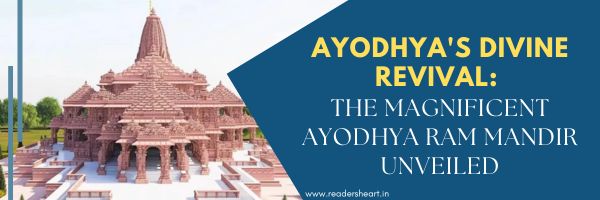
After waiting for more than 500 years with lots of sacrifice, hope, and devotion, the holy place “Ayodhya” is all set to shower benediction to the pilgrimage. The Ayodhya Ram Mandir has already been opened for people to get blessings from lord Ram. Earlier, the city was known for its significant rich history and cultural heritage, but it is now known for the astonishing Ram Mandir as the symbol of positivity over negativity.
The city, which is centered on the Sarayu River, is well-known for its religious significance and ancient Indian civilization. The mandir, a majestic temple in Ayodhya that attests to the community’s tenacity and the eternal spirit of devotion, lies in the center of the city’s cultural richness. This page explores the key details about the mandir, such as its architectural features and importance.
Ayodhya Ram Mandir: A Living Example of good over evil
Concerning Ayodhya Ram Mandir Built on the location of Ram Janmabhoomi, the mythological birthplace of Lord Rama, the Ayodhya Ram Mandir, also known as the Ayodhya Temple, is an important pilgrimage for Hindus. Ram Mandir occupies 4 hectares, while the remaining 23 hectares have been transformed into a complex that includes a canteen, educational center, lecture hall, prayer hall, and museum, among other amenities. 70,000 worshippers can be accommodated at once in the temple complex.
Glimpse of the History
The temple in Ayodhya, Uttar Pradesh, was built on the site of the 16th-century Babri Masjid. The land was disputed between Hindus and Muslims, with Hindus claiming it was the original site of a temple. In 2019, the Supreme Court of India ordered the disputed land to be restored to Hindus for a temple, while Muslims were given nearby land for a mosque. A report by the Archaeological Survey of India suggests a non-Islamic structure beneath the demolished Babri Masjid.
Architecture of the Temple
The Ram Mandir, the world’s third-largest Hindu temple, was designed by the Sompura family of Allahabad in 1988. The temple, built in the Maru-Gurjara Nagara style, is 250-foot wide, 380-foot long, and 161-foot high. The complex, which includes five mandapas and five halls, is built on an elevated platform and features dedicated temples to various Hindu deities. The temple complex is interspersed with 366 columns, each with 16 statues representing Shiva, Saraswati, Chausath Yoginis, and the 10 Dashavataras. The temple complex is adorned with shikharas and features idols of Hindu mythology. The temple complex is located on the southern and northern arms of the complex.
Construction and Facilities
The Ayodhya Temple, built from 6,000 cubic feet of sandstone from Rajasthan, uses 10,000 copper plates for fusing the stone blocks. Thailand contributed soil to the Ram Janmabhoomi. Accessible with ramps, lifts, and provisions for the elderly and differently-abled, the temple houses a pilgrim facility center for 25,000 people, medical and locker services, and 70% of the 70-acre area is green space.
Highlights of The Main Temple and Garbhagriha
The Ayodhya Ram shrine’s main shrine is a soaring example of the magnificence of Hindu temple building. The five Mandaps, or halls, of the Ayodhya temple are Nritya, Sabha, Rang, Kirtan, and Prarthna. It is constructed in the Nagara style. The three storeys of the Ayodhya Ram Temple are intended to provide worshipers with a spiritual experience of the various phases of Lord Rama’s trip.
It exudes luxury with its 44 doors, some of which are covered in 100 kg of gold. Ramayana characters greet you at the Singh Dwar, the main gateway. India’s past is reflected in the elaborate carvings and gods that cover the walls and pillars. The parikrama path’s columns and walkways are inscribed with 100 incidents from Valmiki’s Ramayana.
The Deity – Overlook
The main motivation behind the construction of the Ayodhya Temple was to honor Lord Rama’s birthplace. In keeping with such philosophy, the temple’s chief deity is a young Lord Rama, who is also a manifestation of Lord Vishnu. Ram Lalla is the name Tulsidas gave to the newborn form of Rama; so, the local Hindus call the idol of Rama Ram Lalla Virajman. The Ayodhya Temple’s presiding deity, Balak Ram, also known as Ram Lalla, was created by sculptor Arun Yogiraj. The two tailors, Bhagwat Prasad and Shankar Lal, who are the fourth generation to tailor to Lord Rama’s idol, sewed the outfit for Bhumi Pujan Ram Lalla.
Ayodhya Ram Janmabhoomi Mandir – Important Facts
- Chandrakant Sompura, Ashish Sompura, and Nikhil Sompura are the chief architects.
- Larsen and Toubro is a construction company (L&T).
- The National Institute of Rock Mechanics, the National Geo Research Institute, the Central Building Research Institute in Roorkee, IIT Guwahati, IIT Bombay, and NIT Surat served as design advisors.
- Ganesh Bhatt, Satyanarayan Pandeym, and Arun Yogiraaj are the sculptors.
- Seventy acres in total
- Area of Temple: 77 Acres
- Indian Nagar architectural style
- Architectural highlights include 3 floors, 44 doors, and 392 pillars.
Prana Pratishtha Samaaroh on Glance
The Bhumi Pujan for Ram Mandir construction began on 5 August 2020, with Prime Minister Narendra Modi performing the ceremony on 22 January 2024. The Shri Ram Janmabhoomi Teerth Kshetra organized the opening ceremony. Modi took an 11-day fast, living only on coconut water and fruits, and slept on the floor at night. The consecration ceremony took place on 22 January 2024, and he urged the nation to celebrate Diwali.
Significance of Ram Mandir in Ayodhya, Uttar Pradesh
The Ayodhya Ram Mandir, located in Uttar Pradesh, is a significant symbol of India’s cultural and historical heritage. It brings an end to long-standing differences between Muslims and Hindus and fosters mutual understanding and harmonious cohabitation. The temple symbolizes unity and connects people to their roots and shared history. The construction of the Ram Mandir also aims to improve the community’s welfare by setting up places for community activities and promoting mutual support. Economically, the temple is expected to boost tourism, business growth, and prosperity in Ayodhya, Uttar Pradesh.
Other Places to Explore in Ayodhya During Ram Mandir Visit
Visit Ayodhya City’s ancient shrines, including the Ayodhya Temple and Ram Mandir, which are rich in folklore and connected to the epic Ramayana. Spend at least two nights exploring these spiritual landmarks, which are primarily rooted in the Ramayana.
- Explore the mythical Sita ki Rasoi, a palace believed to be a gift from Lord Rama’s mother, Kaikeyi, to learn about the culinary skills of Sita.
- Visit Kanak Bhawan, a palace with intricate architecture and historical connections.
- Visit Hanuman Garhi, a temple dedicated to Lord Hanuman, and Treta Ke Thakur, where Lord Rama performed the Ashvamedha Yagna.
- Visit Nageshwarnath Temple, dedicated to Lord Shiva, for religious significance.
- Take a boat ride to the Sarayu River Ghats, where the river offers cultural and religious significance.
- Visit Tulsi Smarak Bhawan, dedicated to poet-saint Tulsidas.
Timing To Visit the Temple To Avoid Any Hustle
Before visiting the Ayodhya Temple, check the timings for darshan and aarti. Darshan starts at 7:00 am and closes at 02:00 pm. Aarti occurs every day at 6:30 am, 12 noon, and 7:30 pm. Passes are required for the aarti ceremony, which is called Shringar or Jagaran Aarti, Bhog Aarti, or Sandhya Aarti. The Ayodhya Mandir pooja timings vary.
